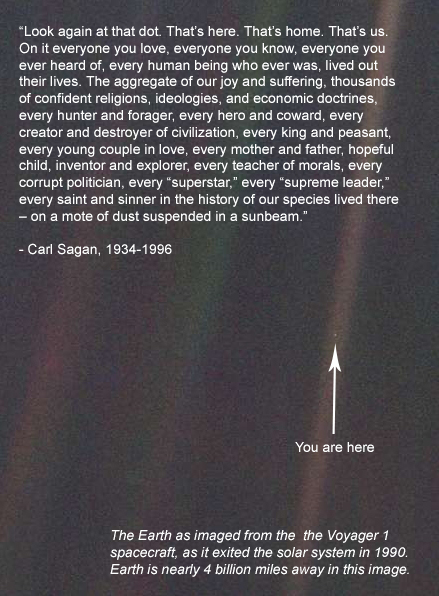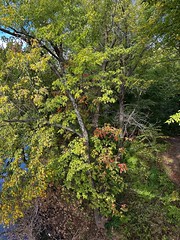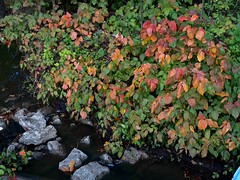 The other day I had to choke back the tears in class again, for I always break down when I mention Carl Sagan and the Pale Blue Dot.
The other day I had to choke back the tears in class again, for I always break down when I mention Carl Sagan and the Pale Blue Dot.
Carl was a great popularizer of science and astronomy, perhaps best known for his inimitable way of saying “billions” where he always emphasized the b. His PBS television series Cosmos influenced me greatly with its spectacular scope and vision. [At this writing, you can view Cosmos on hulu.com!]
I loved his books, especially Broca’s Brain: Reflections on the Romance of Science, The Dragons of Eden: Speculations on the Evolution of Human Intelligence
, and the “baloney detection kit” from his The Demon-Haunted World: Science as a Candle in the Dark
. He was a great agnostic skeptic of tremendous eloquence and sincerity. I love how he convinced NASA to put messages on the Pioneer and Voyager probes that would be leaving our solar system. Messages that could, in some distant future, possibly be found by aliens and be a remembrance of our civilization.
But the Pale Blue Dot always makes me cry. Sagan convinced NASA to have Voyager 1, as it exited the solar system in 1990, turn its view back toward the sun and snap one last photo of our planet. Earth showed up as a pale blue dot – a single pixel in the grainy image. Sagan capitalized on the power of that symbol in a commencement address he gave in 1996 a few months before his death:
Look again at that dot. That’s here. That’s home. That’s us. On it everyone you love, everyone you know, everyone you ever heard of, every human being who ever was, lived out their lives. The aggregate of our joy and suffering, thousands of confident religions, ideologies, and economic doctrines, every hunter and forager, every hero and coward, every creator and destroyer of civilization, every king and peasant, every young couple in love, every mother and father, hopeful child, inventor and explorer, every teacher of morals, every corrupt politician, every “superstar,” every “supreme leader,” every saint and sinner in the history of our species lived there – on a mote of dust suspended in a sunbeam.
The Earth is a very small stage in a vast cosmic arena. Think of the rivers of blood spilled by all those generals and emperors so that, in glory and triumph, they could become the momentary masters of a fraction of a dot. Think of the endless cruelties visited by the inhabitants of one corner of this pixel on the scarcely distinguishable inhabitants of some other corner, how frequent their misunderstandings, how eager they are to kill one another, how fervent their hatreds.
Our posturings, our imagined self-importance, the delusion that we have some privileged position in the Universe, are challenged by this point of pale light. Our planet is a lonely speck in the great enveloping cosmic dark. In our obscurity, in all this vastness, there is no hint that help will come from elsewhere to save us from ourselves.
The Earth is the only world known so far to harbor life. There is nowhere else, at least in the near future, to which our species could migrate. Visit, yes. Settle, not yet. Like it or not, for the moment the Earth is where we make our stand.
It has been said that astronomy is a humbling and character-building experience. There is perhaps no better demonstration of the folly of human conceits than this distant image of our tiny world. To me, it underscores our responsibility to deal more kindly with one another, and to preserve and cherish the pale blue dot, the only home we’ve ever known.
Thanks, Carl, for the Pale Blue Dot, even though it always make me cry.






One of my favorite photos of all time! truly awe inspiring. I recently discovered all of the episodes of “Cosmos” on Hulu.com. If only all of our world leaders possessed the humility, insight, and intelligence of Carl Sagan.
Joseph, I’m so glad to find out Cosmos is available on Hulu! Thanks for the tip – I’m inserting that into my post.